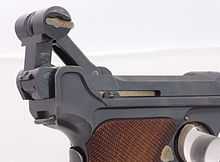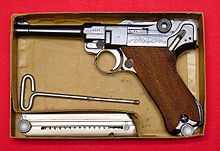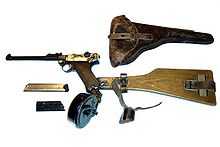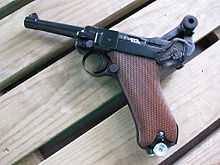Luger pistol
| Luger P08 (Parabellum) | |
|---|---|
 P08 of the Reichsmarine | |
| Type | Semi-automatic pistol |
| Place of origin | German Empire |
| Service history | |
| In service |
German Empire (1904–1918) Weimar Republic (1919–1933) Nazi Germany (1933–1945) Switzerland (1900–early 1970s) Other countries (1900–present) |
| Used by | See Users |
| Wars |
World War I German Revolution Spanish Civil War World War II Second Sino-Japanese War Chinese Civil War Rhodesian Bush War |
| Production history | |
| Designer | Georg J. Luger |
| Manufacturer | Deutsche Waffen und Munitionsfabriken, Imperial Arsenals of Erfurt and Spandau, Simson, Krieghoff, Mauser, Vickers Ltd, Waffenfabrik Bern |
| Unit cost | $13 or 32 RM |
| Produced | 1901–1942 |
| Specifications | |
| Weight | 871 grams (1.92 lbs) |
| Length | 222 mm (8.74 in) |
| Barrel length |
95–200 mm (3.74–7.87 in) |
|
| |
| Cartridge |
7.65×21mm Parabellum 9×19mm Parabellum .45 ACP (rare) |
| Action | Toggle-locked, short recoil |
| Rate of fire | Semi-automatic |
| Muzzle velocity | 350–400 m/s (1148–1312 f/s; 9mm, 100 mm barrel) |
| Effective firing range | 50 m (9mm, 100 mm barrel; short barrel) |
| Feed system | 8-round detachable box magazine, 32-round detachable drum |
| Sights | Iron sights |
The Pistole Parabellum 1908 — or Parabellum-Pistole (Pistol Parabellum) — [1] is a toggle-locked recoil-operated semi-automatic pistol. The design was patented by Georg J. Luger in 1898 and produced by German arms manufacturer Deutsche Waffen- und Munitionsfabriken (DWM) starting in 1900 with other manufacturers such as W+F Bern, Krieghoff, Simson, Mauser and Vickers;[2] it was an evolution of the 1893 Hugo Borchardt–designed C-93. The first Parabellum pistol was adopted by the Swiss army in May 1900. In German Army service, it was succeeded and partly replaced by the Walther P38 in caliber 9mm Parabellum.
The Luger is well known from its use by Germans during World War I and World War II, along with the interwar Weimar Republic and the postwar East German Volkspolizei. Although the P.08 was introduced in 7.65mm Parabellum, it is notable for being the pistol for which the 9x19mm Parabellum (also known as the 9mm Luger) cartridge was developed.
Design details



One of the first semi-automatic pistols, the Luger was designed to use a toggle-lock action, which uses a jointed arm to lock, as opposed to the slide actions of almost every other semi-automatic pistol. After a round is fired, the barrel and toggle assembly (both locked together at this point) travel rearward due to recoil. After moving roughly 0.5 in (13 mm) rearward, the toggle strikes a cam built into the frame, causing the knee joint to hinge and the toggle and breech assembly to unlock. At this point the barrel impacts the frame and stops its rearward movement, but the toggle assembly continues moving (bending the knee joint) due to momentum, extracting the spent casing from the chamber and ejecting it. The toggle and breech assembly subsequently travel forward under spring tension and the next round from the magazine is loaded into the chamber. The entire sequence occurs in a fraction of a second. This mechanism works well for higher-pressure cartridges, but cartridges loaded to a lower pressure can cause the pistol to malfunction because they do not generate enough recoil to work the action fully. This results in either the breech block not clearing the top cartridge of the magazine, or becoming jammed open on the cartridge's base.[3]
In World War I, as submachine guns were found to be effective in trench warfare, experiments with converting various types of pistols to machine pistols (Reihenfeuerpistolen, literally "row-fire pistols" or "consecutive fire pistols") were conducted. Among those the Luger pistol (German Army designation Pistole 08) was examined; however, unlike the Mauser C96, which was later manufactured in a selective-fire version (Schnellfeuer) or Reihenfeuerpistolen, the Luger proved to have an excessive rate of fire in full-automatic mode.
The Luger pistol was manufactured to exacting standards and had a long service life. William "Bill" Ruger praised the Luger's 145° (55° for Americans) grip angle and duplicated it in his .22 LR pistol.
Service
The Swiss Army evaluated the Luger pistol in 7.65×21 mm Parabellum and adopted it in 1900 as its standard side arm, designated Ordonnanzpistole 00 or OP00, in 1900. This model uses a 120 mm barrel.
The Luger pistol was accepted by the Imperial German Navy in 1904. The Navy model had a 150 mm barrel and a two-position (100/200 metre) rear sight. This version is known as Pistole 04.
In 1908 the German Army adopted the Luger to replace the Reichsrevolver in front-line service. The Pistole 08 (or P.08) had a 100 mm barrel and was chambered in 9×19 mm Parabellum. The P.08 was the usual side arm for German Army personnel in both world wars, though it was being replaced by the Walther P38 starting in 1938. In 1930, Mauser took over manufacture of the P.08 (until 1943).[4]
The Bolivian Army adopted the DWM Luger in 9 mm Parabellum as the main officer's side arm in 1908; a few hundred were bought, starting with a batch of about 250 that were included in an order of 4,000 Mauser DWM 1907 rifles and 1,000 Mauser DWM 1907 short rifles, both in caliber 7.65×53 mm, and continued with smaller batches every year until 1913. Only the first batch wore crests and the Legend "Ejercito Boliviano" stamped in the receiver.


The Lange Pistole 08 (German: "Long Pistol 08") or Artillery Luger was a pistol carbine for use by German Army artillerymen as a sort of early Personal Defense Weapon. It had a 200 mm barrel, an 8-position tangent rear sight (calibrated to 800 metres) and a shoulder stock with holster. It was sometimes used with a 32-round drum magazine (Trommelmagazin 08). It was also available in various commercial carbine versions with yet longer barrels.
The firm Armeria Belga of Santiago Chile, manufactured the Benke Thiemann retractable stock that could fold out from the grip section.
The United States evaluated several semi-automatic pistols in the late 19th century, including the Colt M1900, Steyr Mannlicher M1894, and an entry from Mauser. In 1900 the US purchased 1000 7.65 mm Lugers for field trials. Later, a small number were sampled in the then-new, more powerful 9 mm round. Field experience with .38 caliber revolvers in the Philippines and ballistic tests would result in a requirement for still-larger rounds.

In 1906 and 1907, the US Army held trials for a large-caliber semi-automatic. DWM provided two sample Luger pistols chambered in .45 ACP for testing, with serial numbers 1 and 2. The fate of serial number 1 is unknown, as it was not returned. The serial number 2 Luger .45 passed the tests, and survived to be traded among collectors. Its rarity gives its value of around US$1 million at the time the "Million Dollar Guns" episode of History Channel's "Tales of the Gun" was filmed,[5] recheck by Guns & Ammo as of 1994.[6]
At least two pistols were manufactured later for possible commercial or military sales, and one is exhibited at the Norton Gallery, in Shreveport, Louisiana. The other was sold in 2010 and remains in a private collection. After initial trials, DWM, Savage, and Colt were asked to provide further samples for evaluation. DWM withdrew for reasons that are still debated, though the Army did place an order for 200 more samples. A single .45 Luger carbine is also known to exist.[7]
In 1936 Mauser phased out "straw finishing" the small parts and levers on their pistols, choosing to blue them with the rest of the weapon. When in combination with black bakelite grip panels, used on some examples starting in 1941, these pistols were named the "Black Widow" model by a postwar US arms dealer as a marketing ploy.
Captured Lugers were much prized by Allied soldiers during both of the World Wars as War Trophies and could sell for $100. However, German soldiers were aware of this and, during World War 2, would use Lugers as "bait", rigging them to detonate land mines or hidden booby traps when disturbed.[8] This tactic was common enough to make experienced Allied soldiers deeply suspicious of an apparently discarded Luger that was discovered.[9]
Luger Rifle M1906

A rifle was found and put on auction and was said to be made by George Luger. The rifle uses the same mechanism as the pistol. The description mentioned a German patent No. 4126 of 1906. Only a few were made and are rarely found.[citation needed]
Usage today

Although outdated, the Luger is still sought after by collectors both for its sleek design and accuracy, and for its connection to Imperial and Nazi Germany. Limited production of the P.08 by its original manufacturer resumed when Mauser refurbished a quantity of them in 1999 for the pistol's centennial. More recently, Krieghoff announced[10] the continuation of its Parabellum Model 08 line with 200 examples at $17,545.00 apiece.
In 1923, Stoeger, Inc. obtained the American copyright for the "Luger" name for the import of German-built parabellum pistols into the United States. The 1923 commercial models, in .30 Luger and 9mm, and with barrel lengths from 75 mm to 600 mm were the first pistols to bear the name "Luger", roll stamped on the right side of the receiver. Stoeger has retained the rights to the "Luger" name. Over the past seven decades, Stoeger imported a number of different handguns under the "Luger" mark, including an Erma-built .380 version and an American-manufacture .22 which only remotely resembled the original design.[11]
In 1991, the Houston, Texas firm of Aimco, Inc. began making an all new remake of the original Georg Luger design. At that time Mitchell Arms, Inc., under the "Mitchell" name marketed Aimco’s "new" parabellum. Stoeger, Inc. bought the rights to market the Texas-built pistols in 1994, and since that time the "Luger" name is once again on these toggle-action autoloaders.
Stoeger’s current offering is named the "American Eagle" model. This refers to the U.S. eagle roll-stamped above the chamber, closely resembling the eagle used to mark the original pistols designated for U.S. import. The "American Eagle" is available in 4-inch and 6-inch barrel lengths in 9mm Luger only.[12]
Thousands were taken home by returning Allied soldiers during both wars, and are still in circulation today. Colonel David Hackworth mentions in his autobiography that it was still a sought-after sidearm in the Vietnam War. Recently the first serious study on the Post World War II Luger has been published (The Parabellum is Back! 1945–2000); it covers the Luger production from 1945 until 2000. In fact, in 1945 Mauser set up again the Luger production under the control of the French forces. In 1969, Mauser Werke in Oberndorf restarted the production until 1986 when the last commemorative model was produced.[13]
Users
-
 Bolivia[14]
Bolivia[14] -
 Brazil[15]
Brazil[15] -
 Kingdom of Bulgaria[16]
Kingdom of Bulgaria[16] -
 East Germany: Used by Stasi agents.[2]
East Germany: Used by Stasi agents.[2] -
.svg.png) Empire of Japan: Uses Luger pistols in a semi-official capacity taken from disarmed Dutch forces in Indonesia.[2]
Empire of Japan: Uses Luger pistols in a semi-official capacity taken from disarmed Dutch forces in Indonesia.[2] -
 France: Equipped with Luger pistols after the end of France's occupation by Nazi troops.[2]
France: Equipped with Luger pistols after the end of France's occupation by Nazi troops.[2] -
 Finland[17]
Finland[17] -
 Germany[18]
Germany[18]
-
Imperial State of Iran[2]
-
 Netherlands: Equipped with Vickers-made Luger pistols.[2]
Netherlands: Equipped with Vickers-made Luger pistols.[2] -
 Portugal[20][21]
Portugal[20][21] -
 Republic of China[2]
Republic of China[2] -
 Switzerland[17]
Switzerland[17] -
 Turkey[21]
Turkey[21]
Non-State Entities
See also
References
- Citations
- ↑ Fitzsimons, Bernard, ed. The Illustrated Encyclopedia of Weapons and Warfare (London: Phoebus, 1977), Volume 16, p.1778, "Luger".
- ↑ 2.0 2.1 2.2 2.3 2.4 2.5 2.6 http://www.chuckhawks.com/dwm_luger.htm
- ↑ Hogg, Ian & Weeks, John. "Military Small Arms of the 20th Century". Krause Publications. (2000) ISBN 0-87341-824-7
- ↑ Fitzsimons, p.1778.
- ↑ "Tales of the Gun: Million Dollar Guns". History channel.
- ↑ "Would you Shoot the Million Dollar Luger". Guns and Ammo. InterMedia Outdoors.
- ↑ "Investment Firearm - .45 Luger Carbine". rennlist.com.Archived May 25, 2004 at the Wayback Machine
- ↑ Rottman p.49
- ↑ Rottman p.32
- ↑ http://www.krieghoff.com/content/view/176/145/
- ↑ http://pdf.textfiles.com/manuals/FIREARMS/stoeger_luger.pdf
- ↑ http://www.lugerforum.com/lugerinox.html
- ↑ Bishop, Chris (1998). The Encyclopedia of Weapons of World War II. New York: Orbis Publiishing Ltd. ISBN 0-7607-1022-8.
- ↑ Walter, John (1991). Luger Book: The Encyclopedia of the Borchardt and Borchardt-Luger Handguns, 1885-1985. Arms & Armour. p. 66. ISBN 978-0853688860.
- ↑ Walter, John. The Luger Story. Greenhill Books. p. 127. ISBN 1-85367-436-2.
- ↑ Miller, David. Fighting Men of World War II, Volume I: Axis Forces--Uniforms, Equipment, and Weapons (Fighting Men of World War II). Stackpole Books. p. 369. ISBN 0-8117-0277-4.
- ↑ 17.0 17.1 Davis, Aaron (2006). Standard Catalog of Luger. Gun Digest Books; 2 edition ISBN 0-89689-411-8
- ↑ Miller, David (2001). The Illustrated Directory of 20th Century Guns. Salamander Books Ltd. ISBN 1-84065-245-4.
- ↑ 19.0 19.1 19.2 Bishop, Chris, ed. (2002). The Encyclopedia of Weapons of World War II. Metrobooks. p. 228. ISBN 1-58663-762-2. Retrieved 2010-03-02.
- ↑ Armamento do Exército Português, Vol.I - Armamento Ligeiro, António José Telo, Mário Álvares, 2004, p. 100 to 103, ISBN 972-8816-43-X
- ↑ 21.0 21.1 http://www.handgunsmag.com/2010/11/11/featured_handguns_po8_luger/
- ↑ http://usacac.army.mil/cac2/cgsc/carl/download/csipubs/ArtOfWar_RhodesianAfricanRifles.pdf
- Bibliography
Rottman, Gordon (2011). World War II Axis Booby Traps and Sabotage Tactic. Osprey Publishing. ISBN 178096143X.
Further reading
- Imperial Lugers by Jan C. Still (Still's Books, 1994)
- Third Reich Lugers by Jan C. Still (Still's Books, 1988)
- Weimar Lugers by Jan C. Still (Still's Books, 1993)
- Lugers at Random by Charles Kenyon (Hand Gun Press, 1990)
- La Luger Artiglieria by Mauro Baudino (Editoriale Olimpia, 2004)
- Luger Book: The Encyclopedia of the Borchardt and Borchardt-Luger Handguns, 1885–1985 by J. Walter (Arms & Armour, 1991)
- The Parabellum is Back!
- Imperial Lugers Ян С. Тем не менее (Стилла Книги, 1994)
- Рейх Lugers Яна С. Тем не менее (Стилла Книги, 1988)
- Веймар Lugers Ян С. Тем не менее (Стилла Книги, 1993)
- Lugers наугад Чарльз Кеньон (Hand Gun Пресс, 1990)
- La Люгер Artiglieria Мауро Baudino (Editoriale Олимпия, 2004)
- Luger Книга: Энциклопедия Борхардт и Борхардт-Luger пистолетов, 1885-1985 Дж. Уолтера (Arms & Armour, 1991)
- Парабеллум вернулся! 1945–2000 by Mauro Baudino and Gerben van Vlimmeren (Simpson Ltd, 2010)
- The Mauser Parabellum 1930–1946: Analysis of a Million Luger Pistols by Don R. Hallock & Joop van den Kant (HaKa Arms Publications C0, 2010) 1945-2000 Мауро Baudino и Gerben ван Vlimmeren (Симпсон Ltd, 2010)
- Маузер Парабеллум 1930-1946: Анализ Million Luger Pistols Дон Р. Халлок & Joop Van Den Кант (Хака Руки Публикации С0, 2010)
External links
| Wikimedia Commons has media related to P08 Parabellum. |
- The Million Dollar Luger
- Luger Artillery and Mauser Parabellum
- Luger 08 in parts
- Modern Firearms
- Bulgarian Luger 08 on GunsTribune
- The history of the Luger pistol from 1945 until 2000
- A Luger-related searchable database with hundreds of photos and values
- Anleitung zur Kenntnis und Behandlung der Pistole 1900/06 (1911 German manual)
- Technisches Reglement Nr T 4 D - Die Pistole (P 06/29) - 1944 Swiss manual for the Luger.
- Maßtafeln zur Pistole 08 und langen Pistole 08
- Luger Pistol M1900 Blueprints
- Luger Pistol M1904 Blueprints
- Luger Pistol M1906 Blueprints
| ||||||||||||||||||||||||||